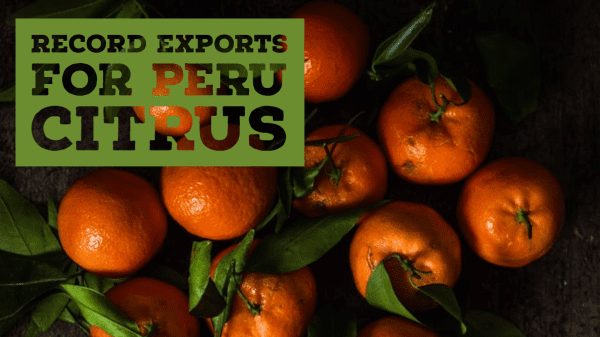
Peru is on track for record citrus exports as it hits the mid-point of peak summer season.
According to Sergio del Castillo Valderrama, the general manager of Citrus Producers of Peru (ProCitrus), Peru’s citrus campaign (mandarin, orange, tangelo, grapefruit, and limes) is estimated to produce 1.44 million tons, as reported by Agraria.
Del Castillo pointed out that 20 percent (300,000 tons) would be going to the international market, which would be a record volume of exports, with 80 percent staying in the domestic market.
“The covid-19 pandemic has generated a rebound in commercialization worldwide due to the multiple properties that citrus fruits have and that help strengthen the immune system”, he stated.

Production-wise, mandarins would reach 528,000 tons (212,000 tons would be exported), oranges 560,000 tons (32,000 tons would be exported), Sutil limes 300,000 tons (10,000 tons would be exported), Tahiti limes 20,000 tons (15,000 tons would be exported), grapefruits 6,500 tons (2,500 tons would be exported) and tangelos 30,000 tons (18,000 tons would be exported).
Peru has about 70,000 hectares of citrus fruits: 25,000 hectares of oranges, 23,000 hectares of limes, and 22,000 hectares of mandarin, Del Castillo said.
He added that at week 22, Peru exported 68,333 tons of citrus, representing a quarter of what was estimated for this year’s campaign. The late season beginning in June and lasting until August is the peak of exports for mandarin and oranges.
The main destination markets for mandarins, the main citrus exported, is the U.S., which for now a little over 14,000 tons has been shipped, followed by UK with 11,000 tons, the Netherlands with 10,000 tons, China with 5,000 tons, and Canada with 5,000 tons.
Peru is on track for record citrus exports as it hits the mid-point of peak summer season.
According to Sergio del Castillo Valderrama, the general manager of Citrus Producers of Peru (ProCitrus), Peru’s citrus campaign (mandarin, orange, tangelo, grapefruit, and limes) is estimated to produce 1.44 million tons, as reported by Agraria.
Del Castillo pointed out that 20 percent (300,000 tons) would be going to the international market, which would be a record volume of exports, with 80 percent staying in the domestic market.
“The covid-19 pandemic has generated a rebound in commercialization worldwide due to the multiple properties that citrus fruits have and that help strengthen the immune system”, he stated.

Production-wise, mandarins would reach 528,000 tons (212,000 tons would be exported), oranges 560,000 tons (32,000 tons would be exported), Sutil limes 300,000 tons (10,000 tons would be exported), Tahiti limes 20,000 tons (15,000 tons would be exported), grapefruits 6,500 tons (2,500 tons would be exported) and tangelos 30,000 tons (18,000 tons would be exported).
Peru has about 70,000 hectares of citrus fruits: 25,000 hectares of oranges, 23,000 hectares of limes, and 22,000 hectares of mandarin, Del Castillo said.
He added that at week 22, Peru exported 68,333 tons of citrus, representing a quarter of what was estimated for this year’s campaign. The late season beginning in June and lasting until August is the peak of exports for mandarin and oranges.
The main destination markets for mandarins, the main citrus exported, is the U.S., which for now a little over 14,000 tons has been shipped, followed by UK with 11,000 tons, the Netherlands with 10,000 tons, China with 5,000 tons, and Canada with 5,000 tons.
Marco Campos is Media Coordinator, Latin America for Blue Book Services




